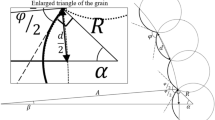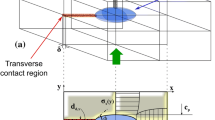Abstract
Pore shrinkage is caused by sintering pressure, and is affected by the curvature of the grains within the surface of pores, as well as variables, like grain size, pore radius, and dihedral angle. The sintering pressure is greatly influenced by the direction of curvature of grains within the pores, which, during the shrinkage of the pore, is sometimes reversed; this is termed curvature reversal. This research aimed to present the curvature reversal condition by means of a geometrical model, and thus the radius of curvature of a grain surface within the pore was calculated according to the dihedral angle assuming a grain size of 0.1–0.3 μm and pore radius of 500 μm. Calculation of the pore shrinkage showed that the sign of the radius of curvature changed along with the rapid increase in absolute value, so this was physically interpreted as curvature reversal. This curvature reversal was observed in the process of shrinking pores, as well as in the change of dihedral angle; the larger the grain and the dihedral angle, the larger the pore radius at which reversal occurred. This paper presents the conditions of curvature reversal during the sintering of powder compact according to the dihedral angle, grain size, and pore size, and discusses the implications for actual sintering.








Similar content being viewed by others
Data availability
The data that support the findings of this study are available on request from the corresponding author.
References
F.F. Lange, Sinterability of agglomerated powders. J. Am. Ceram. Soc. 67, 83–89 (1984)
K.S. Oh, D.Y. Kim, S.J. Cho, Generation of cracklike voids during sintering of Al2O3–ZrO2 ceramics and their prevention by presintering with low pressure (2 MPa). J. Am. Ceram. Soc. 79, 1723–1725 (1996)
S.P. Lee, B. Hwang, Y.K. Paek, T.J. Chung, S.H. Yang, S. Lim, W.S. Seo, K.S. Oh, Determination of the initial heat treatment temperature in the twostep sintering of xAl–ZnO (x=1, 2, and 3 wt%). J. Eur. Ceram. Soc. 33, 131–137 (2013)
J.R. Lee, T.J. Chung, S.H. Yang, G.S. Hong, K.S. Oh, Prevention of tapering in the tube-shaped sputtering target via initial heat treatment under external pressure. Ceram. Int. 41, 3677–3683 (2015)
J.W. Son, D.Y. Kim, P. Boch, Enhanced densification of In2O3 ceramics by presintering with low pressure. J. Am. Ceram. Soc. 81, 2489–2492 (1998)
B. Hwang, Y.K. Paek, S.H. Yang, S. Lim, W.S. Seo, K.S. Oh, Densification of Al-doped ZnO via preliminary heat treatment under external pressure. J. Alloys Compd. 509, 7478–7483 (2011)
B. Hwang, Y.K. Paek, K.S. Oh, Estimation of sintering pressure during the pore fragmentation via coordination number and reversal of curvature. J. Korean Ceram. Soc. 59, 936–943 (2022)
J.H. Im, H.R. Kim, B.G. An, Y.W. Chang, M.J. Kang, T.G. Lee, J.G. Son, J.G. Park, J.C. Pyun, In situ-synthesized cadmium sulfide nanowire photosensor with a parylene passivation layer for chemiluminescent immunoassays. Biosens. Bioelectron. 92, 221–222 (2017)
B.G. An, H.R. Kim, Y.W. Chang, J.G. Park, J.C. Pyun, Photosensors-based on cadmium sulfide (CdS) nanostructures: a review. J. Korean Ceram. Soc. 58, 631–644 (2021)
Y.K. Paek, K.Y. Eun, S.J.L. Kang, Effect of sintering atmosphere on densification of MgO doped Al2O3. J. Am. Ceram. Soc. 71, C380–C382 (1988)
J.J. Kim, B.K. Kim, B.M. Song, D.Y. Kim, D.N. Yoon, Effect of sintering atmosphere on isolated pores during the liquid phase sintering of MgO-CaMgSiO. J. Am. Ceram. Soc. 70, 734–737 (1987)
S.K. Biswas, F.L. Riley, Gas pressure sintering of silicon nitride - current status. Mater. Chem. Phys. 67, 175–179 (2001)
N. Nadaud, M. Nanot, P. Boch, Sintering and electrical properties of titania and zirconia containing In2O3 SnO2 (ITO) ceramics. J. Am. Ceram. Soc. 77, 843–846 (1994)
N. Frage, L. Levin, M.P. Dariel, The effect of the sintering atmosphere on the densification of B4C ceramics. J. Solid State Chem. 77, 410–414 (2004)
C.H. Hsueh, A.G. Evans, R.L. Coble, Overview 22; Microstructure development during final/intermediate stage sintering—I. Pore/grain boundary separation. Acta Metall. 30, 1269–1279 (1982)
J.H. Choi, N.M. Hwang, D.Y. Kim, Pore-boundary separation behavior during sintering of pure and Bi2O3-doped ZnO ceramics. J. Am. Ceram. Soc. 84, 1398–1400 (2001)
L.C. De Jonghe, M.L. Rahaman, Pore shrinkage and sintering stress. J. Am. Ceram. Soc. 67, C214–C215 (1984)
A.G. Evans, C.H. Hsueh, Behavior of large pores during sintering and hot isostatic pressing. J. Am. Ceram. Soc. 69, 444–448 (1986)
R. Raj, Analysis of the sintering pressure. J. Am. Ceram. Soc. 70, C210–C211 (1987)
S.T. Lin, R.M. German, Compressive stress for large-pore removal in sintering. J. Am. Ceram. Soc. 71, C432–C433 (1988)
S.-J.L. Kang, Comment on “Analysis of the sintering pressure.” J. Am. Ceram. Soc. 76, 1902 (1993)
R. Raj, Reply to “Comment on ‘Analysis of the sintering pressure.’” J. Am. Ceram. Soc. 76, 1903 (1993)
C.A. Handwerker, J.M. Dynys, R.M. Cannon, R.L. Coble, Dihedral angles in Magnesia and Alumina: distributions from surface thermal grooves. J. Am. Ceram. Soc. 73, 1371–1377 (1990)
Acknowledgements
This work was supported by a grant from 2023 Research Funds of Andong National University.
Author information
Authors and Affiliations
Corresponding author
Ethics declarations
Conflict of interest
The author declares that they have no known competing financial interests or personal relationships that could have appeared to influence the work reported in this paper.
Additional information
Publisher's Note
Springer Nature remains neutral with regard to jurisdictional claims in published maps and institutional affiliations.
Rights and permissions
Springer Nature or its licensor (e.g. a society or other partner) holds exclusive rights to this article under a publishing agreement with the author(s) or other rightsholder(s); author self-archiving of the accepted manuscript version of this article is solely governed by the terms of such publishing agreement and applicable law.
About this article
Cite this article
Paek, YK., Oh, KS. Curvature reversal condition during pore shrinkage or fragmentation. J. Korean Ceram. Soc. 61, 458–468 (2024). https://doi.org/10.1007/s43207-023-00364-8
Received:
Revised:
Accepted:
Published:
Issue Date:
DOI: https://doi.org/10.1007/s43207-023-00364-8




